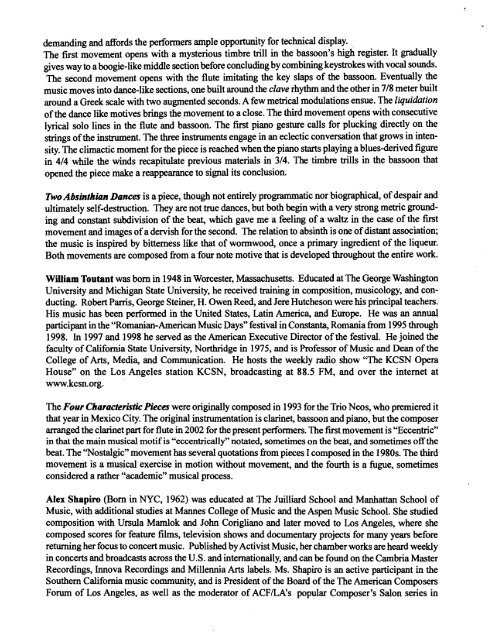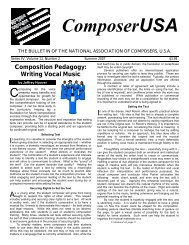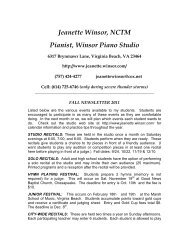1999-2007 - Music-USA.org
1999-2007 - Music-USA.org
1999-2007 - Music-USA.org
Create successful ePaper yourself
Turn your PDF publications into a flip-book with our unique Google optimized e-Paper software.
demanding and affords the performers ample opportunity for technical display.<br />
The first movement opens with a mysterious timbre trill in the bassoon's high register. It gradually<br />
gives way to a boogie-like middle section before concluding by combining keystrokes with vocal sounds.<br />
The second movement opens with the flute imitating the key slaps of the bassoon. Eventually the<br />
music moves into dance-like sections, one built around the clave rhythm and the other in 7/8 meter built<br />
around a Greek scale with two augmented seconds. A few metrical modulations ensue. The liquidation<br />
of the dance like motives brings the movement to a close. The third movement opens with consecutive<br />
lyrical solo lines in the flute and bassoon. The first piano gesture calls for plucking directly on the<br />
strings of the instrument. The three instruments engage in an eclectic conversation that grows in inten-<br />
sity. The climactic moment for the piece is reached when the piano starts playing a blues-derived figure<br />
in 4/4 while the winds recapitulate previous materials in 3/4. The timbre trills in the bassoon that<br />
opened the piece make a reappearance to signal its conclusion.<br />
Two Absinthian Dances is a piece, though not entirely programmatic nor biographical, of despair and<br />
ultimately selfdestruction. They are not true dances, but both begin with a very strong metric ground-<br />
ing and constant subdivision of the beat, which gave me a feeling of a waltz in the case of the first<br />
movement and images of a dervish for the second. The relation to absinth is one of distant association;<br />
the music is inspired by bitterness like that of wormwood, once a primary ingredient of the liqueur.<br />
Both movements are composed fiom a four note motive that is developed throughout the entire work.<br />
William Toutant was born in 1948 in Worcester, Massachusetts. Educated at The Ge<strong>org</strong>e Washington<br />
University and Michigan State University, he received training in composition, musicology, and con-<br />
ducting. Robert Parris, Ge<strong>org</strong>e Steiner, H. Owen Reed, and Jere Hutcheson were his principal teachers.<br />
His music has been performed in the United States, Latin America, and Europe. He was an annual<br />
participant in the "Romanian-American <strong>Music</strong> Days" festival in Constants, Romania fiom 1995 through<br />
1998. In 1997 and 1998 he served as the American Executive Director of the festival. He joined the<br />
faculty of California State University, Northridge in 1975, and is Professor of <strong>Music</strong> and Dean of the<br />
College of Arts, Media, and Communication. He hosts the weekly radio show "The KCSN Opera<br />
House" on the Los Angeles station KCSN, broadcasting at 88.5 FM, and over the internet at<br />
www.kcsn.<strong>org</strong>.<br />
The Four CharacterMc Pieces were originally composed in 1993 for the Trio Neos, who premiered it<br />
that year in Mexico City. The original instrumentation is clarinet, bassoon and piano, but the composer<br />
arranged the clarinet part for flute in 2002 for the present performers. The first movement is "Eccentric"<br />
in that the main musical motif is "eccentrica11y~' notated, sometimes on the beat, and sometimes off the<br />
beat. The "Nostalgic" movement has several quotations fiom pieces I composed in the 1980s. The third<br />
movement is a musical exercise in motion without movement, and the fourth is a fugue, sometimes<br />
considered a rather "academic" musical process.<br />
Alex Shapiro (Born in NYC, 1962) was educated at The Juilliard School and Manhattan School of<br />
<strong>Music</strong>, with additional studies at Mannes College of <strong>Music</strong> and the Aspen <strong>Music</strong> School. She studied<br />
composition with Ursula Mamlok and John Corigliano and later moved to Los Angeles, where she<br />
composed scores for feature films, television shows and documentary projects for many years before<br />
returning her focus to concert music. Published by Activist <strong>Music</strong>, her chamber works are heard weekly<br />
in concerts and broadcasts across the U.S. and internationally, and can be found on the Cambria Master<br />
Recordings, Innova Recordings and Millennia Arts labels. Ms. Shapiro is an active participant in the<br />
Southern California music community, and is President of the Board of the The American Composers<br />
Forum of Los Angeles, as well as the moderator of ACF5A's popular Composer's Salon series in




